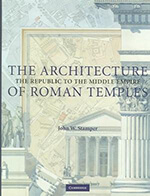The Architecture of Roman Temples: The Republic to the Middle Empire

By Associate Dean John Stamper
With The Architecture of Roman Temples: The Republic to the Middle Empire (Cambridge University Press, 2005), Associate Dean John Stamper examines the development of Roman temple architecture from its earliest history in the sixth century BC to the reigns of Hadrian and the Antonines in the second century A.D.
Prof. Stamper begins with a challenge to the currently accepted reconstruction of the Temple of Capitoline Jupiter, arguing that its width, length, height and interaxial spacings are far too large for the technology of Roman builders in the sixth-century B.C. Because of its exaggerated size, the Capitoline Temple has been viewed---until now---as an anomaly in the history of Roman architecture. This exaggerated size has always made it difficult to relate the Capitoline Temple to either contemporary Etruscan or later Roman temple architecture.
The new reconstruction proposed by Prof. Stamper is based on a different interpretation of the building's physical and written evidence, and it takes into account a comparative study of later temple architecture in Rome. It proposed a building whose dimensions are more compatible with both contemporary and later temples, and thus more within the actual capabilities of builders in the sixth-century B.C. The Temple of Capitoline Jupiter presented here is seen not as an anomaly, but rather, as a paradigmatic building that had a major influence on the designs of many later temple structures and their iconographic programs, at least until the middle of the second century A.D.
Prof. Stamper analyzes the temples' formal qualities, the public spaces in which they were located and, most importantly, the authority of precedent in their designs. He also traces Rome's temple architecture as it evolved over time and how it accommodated changing political and religious contexts, as well as the affects of new stylistic influences.